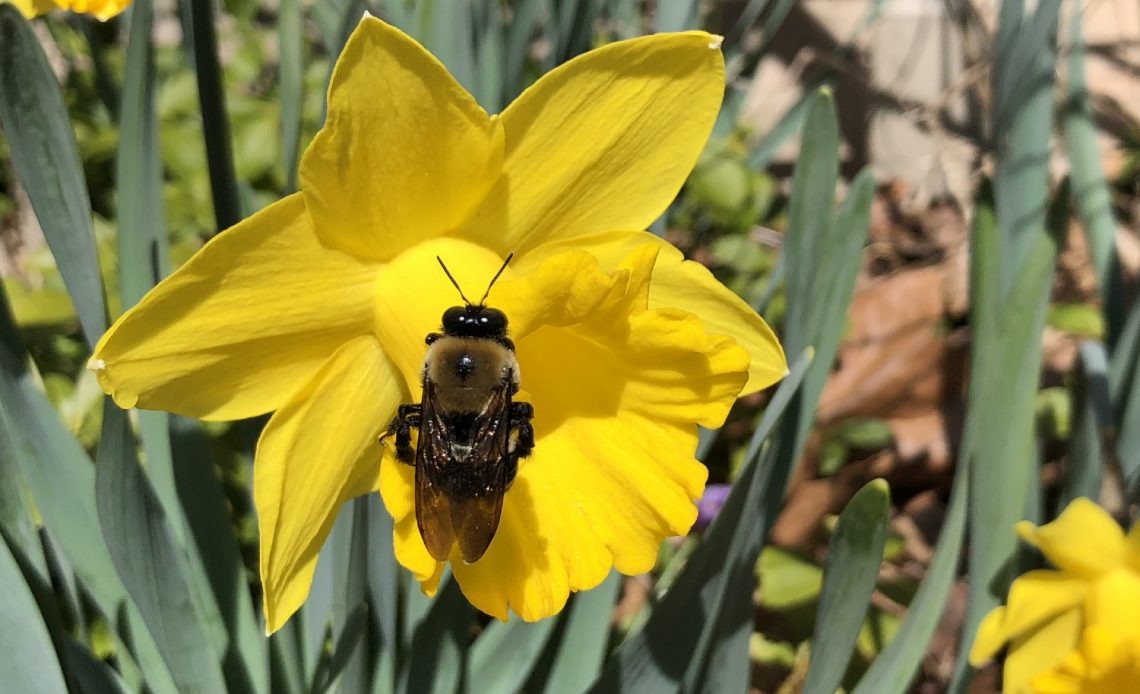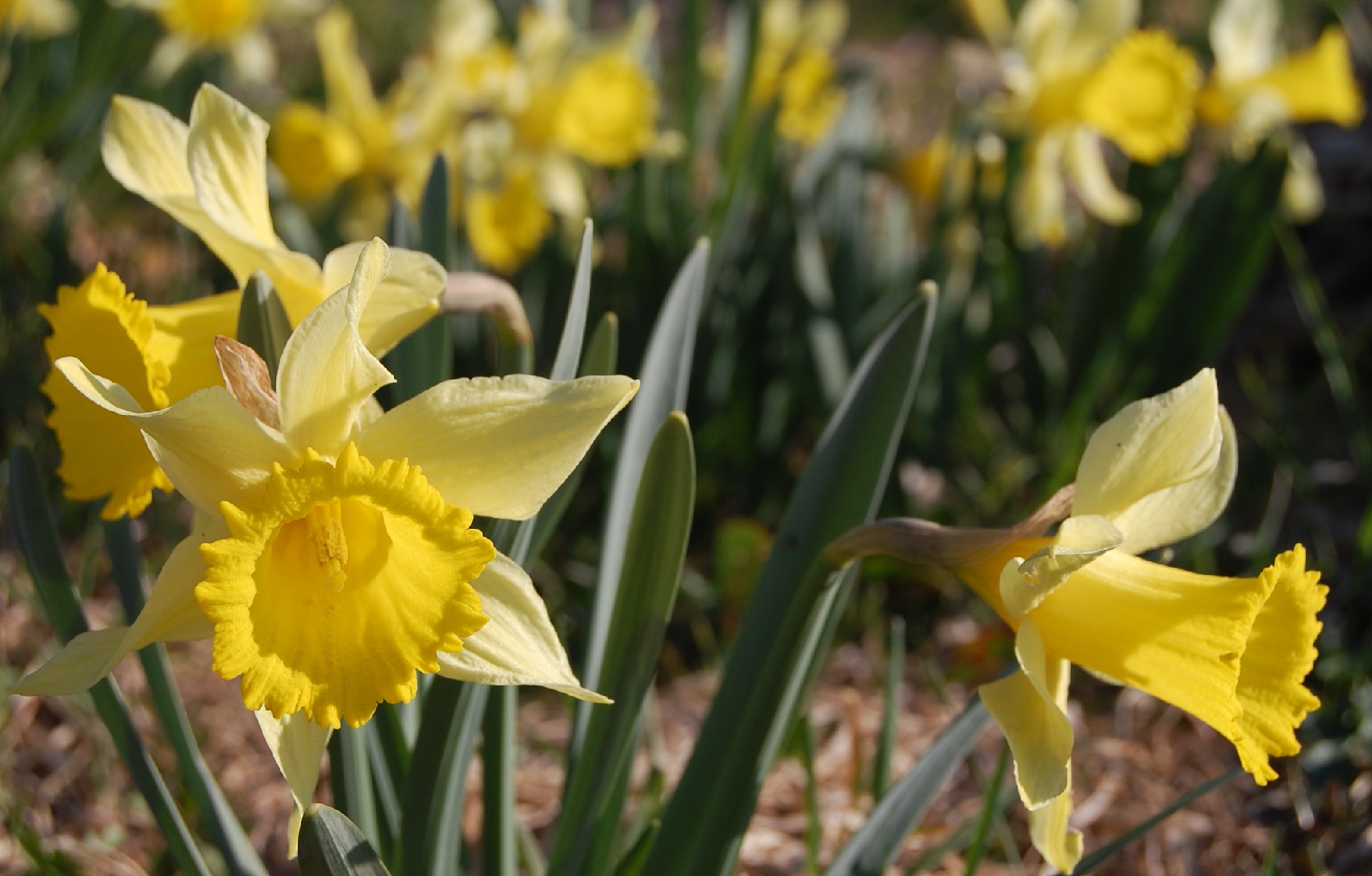

We’re here to help! Wild Yards is a completely free website that is 100% dedicated to helping you create a wildlife-friendly, sustainable yard. Read more
WildYards is reader-supported. When you buy a product through a link on our site, we may earn a comission. Every product is independently selected by our (obsessive) editors and our reviews are unbiased and objective. Read more about our mission or our privacy policy.
Nothing is more exciting than seeing the bulbs you planted in late fall sprout up from the ground in spring. And, what makes it twice as rewarding is knowing that all those bulbs will attract valuable pollinators to your backyard. Bees in particular are big fans of bulb flowers, especially tulips and crocuses. But do bees like daffodils, too?
Bees are attracted to daffodils. But not all daffodils are created equal in a bee’s eyes. If you want to use daffodils to bring in the bees, you’ll have more success with some varieties of daffodils than you will with others.
Why are many daffodils not visited by bees?
There are a few reasons why bees may not be visiting your daffodils. For starters, bees can be pretty picky about which flowers they pollinate. Some bees forage for pollen, others forage for nectar, and some forage for both. They also have their favorite foods the same as us humans. So sometimes, the reason bees aren’t attracted to daffodils is simply that they’re not in the mood for the taste of daffodil pollen and nectar.
Other times, it’s not necessarily that bees don’t like daffodils. It’s just that the flowers are blooming when the bees aren’t around to enjoy them. Daffodils bloom in March. Normally, this is great for bees because that’s right around the time they start waking up from hibernation. They need all the food sources they can get! But, some hives don’t wake up until later in the spring, so they miss out on all that daffodils have to offer.
Another thing to consider is the kind of daffodils you’re growing. While bees generally like bulb flowers, they prefer unhybridized cultivars over hybrids. While hybrids may have flashier, longer-lasting blooms, they’re usually short on pollen and nectar. And that goes for flowering plants across the board, not just daffodils.
If bees aren’t swarming your daffodils the way you’d hoped, it’s likely due to one (or more) of these reasons. Fortunately, there are some things you can do to help bees get the most out of your daffodils. So don’t give up hope just yet!
Which daffodils are best for attracting bees?
If you want the bees to dig your daffodils, it all starts with choosing the correct varieties. Keep your eyes peeled for wild-type daffodils. These are daffodils that have the least interference from mankind, which is to say, these are the daffodils that bees like best. Narcissus jonquilla, Narcissus poeticus, and pseudonarcissus (also simply called wild daffodil) are all wonderful choices for attracting bees. And, as a bonus, these flowers are deer and rabbit resistant!
Remember, bees don’t like hybrids. They just don’t offer enough food to make it worth the bees’ while. So avoid the more popular daffodils, like ‘Merlin’, ‘Jetfire’, and ‘Jack Snipe’, as well as any double bloom varieties. Pretty as they are, they don’t attract many pollinators. If you already have these varieties in your backyard, that’s okay. You don’t have to get rid of them. Just be sure to plant the daffodils bees prefer along with them.
It’s worth noting that daffodils are toxic to people and pets. Keep these flowers out of your backyard if your dogs and cats like to nibble on the greenery. If you keep your bee hives near horses, be sure to grow your daffodils away from them, as well. The last thing you want is to feed your trusty steed a poisonous flower.

Which bulb flowers do bees like the most?
Some bees will choose to go for the same flowers over and over again, no matter how many different kinds are available. But the types of flowers bees choose varies. Some bees may choose dandelions, other bees may choose star jasmine. You can never tell what those little guys will want, so it’s best to take the “box of chocolates” approach and give them a little bit of everything to try.
So when you sit down to create your bulb flower garden plan this fall, be sure to include plenty of different blooms. Aim for four to seven different kinds of bulb flowers. Not only will this keep the bees interested, but it will also dress up your garden.
Start with crocuses and alliums. These vibrant flowers are easy to spot, they’re full of pollen and nectar. They’ve got everything the bees are looking for. Aconite, also ominously known as wolf’s bane, is also a popular choice for bees. Featuring multiple purple, bell-shaped flowers hanging from a single stalk, aconites reflect the sun’s ultraviolet rays, making it easy for bees to see.
Planting other bulb flowers, like hyacinths, snowdrops, camassias, and anemones will provide your bees with plenty of opportunities to pollinate. Include as many of these flowers as you like, just remember to always choose native species whenever possible. Hybrids that are advertised as being particularly fragrant may be appropriate as well, as these species retain more pollen and nectar than other hybrids.
How can you attract bees to your daffodils?
Maybe you’ve done everything right with your daffodils. Maybe you’ve planted the right varieties, maybe you’ve placed them near your hive boxes. And maybe the bees still don’t give two hoots about them. So, just what are you supposed to do to get those finicky little insects interested?
The short answer is to provide them with a readily available source of nectar, which you can do in one of two ways. The first is by setting out a shallow dish filled with hummingbird water. It’s easy to make, and bees love it. Of course, hummingbirds love it, too, as do butterflies. But if your goal is to bring more pollinators to your garden, that’s not a bad thing.
The second way to drum up interest in your daffodils is by setting some fruit nearby. Apples, figs, oranges, peaches, and bananas are great options. And the riper, the better. Overripe fruits emit a strong fragrance that bees are drawn to. They’re also loaded with sugary goodness that’s too tempting for bees to resist.
Once your bees have had their fill of the all-you-can-eat nectar buffet you’ve created just for them (lucky bees!), they’ll be happy to check out your flower garden. Your daffodils will help satisfy the bees’ need for pollen. When they know they can rely on your backyard to provide all their nutritional needs, your local bees will be buzzing right back just as soon as they can!
So, there you have it! Daffodils can be used to attract bees to your garden, but hybrid varieties won’t catch their eyes the way native species will. Planting your unhybridized daffodils with a variety of other unhybridized bulb flowers is the best way to get your regional bee population to notice your backyard.
